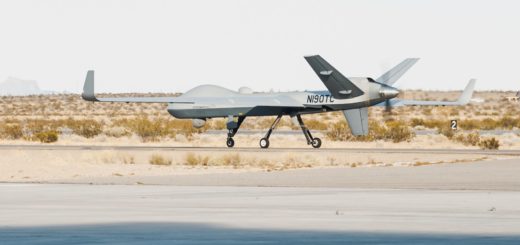Poland’s F-35A Jet Fleet Expands as New Husarz Flight Signals Accelerated Frontline Integration
{loadposition bannertop}
{loadposition sidebarpub}
Poland’s F-35A “Husarz,” aircraft 3505 (AZ-05), completed its maiden flight in Fort Worth on October 17, 2025. The milestone marks tangible progress toward Warsaw’s goal of introducing fifth-generation fighters into frontline service and strengthening NATO’s eastern air defenses.
On Friday, 17 October 2025, Poland’s F-35A “Husarz” 3505 “AZ-05” completed its maiden flight in Fort Worth, as the images published by X user @KpAviationPhoto indicate. This event follows the country’s first Polish-owned F-35A maiden flight on 2 December 2024 (AZ-02, c/n 3502), confirming a steady ramp-up from initial testing to serial production. The milestone matters for Warsaw’s transition to fifth-generation airpower and for NATO’s air posture on the Alliance’s eastern flank, where allied fifth-gen fighters are already operating from Polish bases. It demonstrates that the training, infrastructure and sustainment pieces arranged since 2020 are now converging into capability that will enter service on a credible timeline.
Follow Army Recognition on Google News at this link
With additional Husarz aircraft now flying, pilot pipelines active, F-16 upgrades funded, and allied fifth-gen detachments operating from Polish bases, Warsaw is positioning its air arm to deter and, if required, fight in a contested environment on NATO’s forward line (Picture Source: X-user/@KpAviationPhoto)
The aircraft that flew on 17 October is part of Poland’s 32-jet F-35A package approved and signed on 31 January 2020 under Foreign Military Sales for about $4.6 billion covering airframes, engines, training and initial support. That 2020 agreement framed a multi-year production and acceptance sequence that has now produced multiple Polish-marked jets in flight test. In parallel, Washington cleared an additional F-35 sustainment case in August 2025, estimated at $1.85 billion, for logistics and program support, signaling the long-term cost profile Poland planned for from the outset.
The product entering Polish service is a low-observable multi-role platform designed around fused sensing and electronic warfare effects. Its AN/APG-81 AESA radar, Distributed Aperture System and Electro-Optical Targeting System merge into a single tactical picture and are shared via secure datalinks to adjacent shooters and air defenses. This makes the F-35 an opening-phase asset for suppression and destruction of enemy air defenses, high-value targeting and persistent ISR in contested electromagnetic environments. Where Poland’s F-16C/D Block 52+ “Jastrząb” provides magazine depth and proven multi-role performance, the F-35 adds survivability, cross-domain sensing and battle-management roles that elevate the whole force. Warsaw’s decision in August 2025 to invest $3.8 billion to modernize all 48 F-16s explicitly aims at tighter integration with the F-35, Abrams and Apache fleets for multi-domain operations, a complementary, not duplicative, force design.
Operationally, Poland has been building the human and basing foundation to accept the jets. Ebbing Air National Guard Base in Arkansas has become the hub for Polish F-35 training, with the first Polish pilots flying and graduating there in May 2025 and additional training infrastructure commissioned over the summer. This sequencing, academics, high-fidelity simulators and supervised syllabus flights, ensures that when early Husarz airframes transfer, a cadre of mission-ready aircrew and maintainers is in place to accelerate operational testing and initial QRA contributions.
Context in Poland’s inventory helps explain the capability gain. MiG-29 and Su-22 fleets have been retired or transferred, leaving the F-16 as the current high-end combat backbone while the FA-50/FA-50PL provides affordable capacity for QRA, training and light strike. As FA-50PL deliveries and munitions contracts progress, these aircraft will complement the F-35 by freeing it for tasks where stealth and sensing are decisive, while the upgraded F-16s serve as magazines and strike partners cued by the Husarz’s sensors.
Strategic implications are immediate. Since 2022, NATO has repeatedly stationed strategic air assets in Poland, including U.S. F-22s at Łask under NATO Air Shielding. In 2025, Dutch and Norwegian F-35 detachments began operating from Polish bases under NATO command to secure supply corridors into Ukraine and to conduct air policing. As Poland inducts its own F-35s, allied rotations combine with national squadrons to generate fifth-generation mass, shared tactics and continuous data exchange over Poland’s airspace, complicating any Russian attempt to coerce logistics nodes and civilian infrastructure near the border.
Factually, the new development should be read as acceleration, not a program “start.” According to publicly available reports, the first F-35A Lightning II for Poland completed its maiden flight on 2 December 2024. The 17 October 2025 first flight of airframe 3505 “AZ-05” marks another Polish jet entering the test pipeline, evidence that the production and training rhythm is now established and compressing timelines to operational availability, as the images published by X user @KpAviationPhoto.
Poland has moved beyond announcements into tangible fifth-generation force generation. With additional Husarz aircraft now flying, pilot pipelines active, F-16 upgrades funded, and allied fifth-gen detachments operating from Polish bases, Warsaw is positioning its air arm to deter and, if required, fight in a contested environment on NATO’s forward line. The signal to partners and adversaries is clear: the F-35 era in Poland is no longer theoretical; it is material, resourced and converging on frontline duty.
Written by Teoman S. Nicanci – Defense Analyst, Army Recognition Group
Teoman S. Nicanci holds degrees in Political Science, Comparative and International Politics, and International Relations and Diplomacy from leading Belgian universities, with research focused on Russian strategic behavior, defense technology, and modern warfare. He is a defense analyst at Army Recognition, specializing in the global defense industry, military armament, and emerging defense technologies.

{loadposition bannertop}
{loadposition sidebarpub}
Poland’s F-35A “Husarz,” aircraft 3505 (AZ-05), completed its maiden flight in Fort Worth on October 17, 2025. The milestone marks tangible progress toward Warsaw’s goal of introducing fifth-generation fighters into frontline service and strengthening NATO’s eastern air defenses.
On Friday, 17 October 2025, Poland’s F-35A “Husarz” 3505 “AZ-05” completed its maiden flight in Fort Worth, as the images published by X user @KpAviationPhoto indicate. This event follows the country’s first Polish-owned F-35A maiden flight on 2 December 2024 (AZ-02, c/n 3502), confirming a steady ramp-up from initial testing to serial production. The milestone matters for Warsaw’s transition to fifth-generation airpower and for NATO’s air posture on the Alliance’s eastern flank, where allied fifth-gen fighters are already operating from Polish bases. It demonstrates that the training, infrastructure and sustainment pieces arranged since 2020 are now converging into capability that will enter service on a credible timeline.
With additional Husarz aircraft now flying, pilot pipelines active, F-16 upgrades funded, and allied fifth-gen detachments operating from Polish bases, Warsaw is positioning its air arm to deter and, if required, fight in a contested environment on NATO’s forward line (Picture Source: X-user/@KpAviationPhoto)
The aircraft that flew on 17 October is part of Poland’s 32-jet F-35A package approved and signed on 31 January 2020 under Foreign Military Sales for about $4.6 billion covering airframes, engines, training and initial support. That 2020 agreement framed a multi-year production and acceptance sequence that has now produced multiple Polish-marked jets in flight test. In parallel, Washington cleared an additional F-35 sustainment case in August 2025, estimated at $1.85 billion, for logistics and program support, signaling the long-term cost profile Poland planned for from the outset.
The product entering Polish service is a low-observable multi-role platform designed around fused sensing and electronic warfare effects. Its AN/APG-81 AESA radar, Distributed Aperture System and Electro-Optical Targeting System merge into a single tactical picture and are shared via secure datalinks to adjacent shooters and air defenses. This makes the F-35 an opening-phase asset for suppression and destruction of enemy air defenses, high-value targeting and persistent ISR in contested electromagnetic environments. Where Poland’s F-16C/D Block 52+ “Jastrząb” provides magazine depth and proven multi-role performance, the F-35 adds survivability, cross-domain sensing and battle-management roles that elevate the whole force. Warsaw’s decision in August 2025 to invest $3.8 billion to modernize all 48 F-16s explicitly aims at tighter integration with the F-35, Abrams and Apache fleets for multi-domain operations, a complementary, not duplicative, force design.
Operationally, Poland has been building the human and basing foundation to accept the jets. Ebbing Air National Guard Base in Arkansas has become the hub for Polish F-35 training, with the first Polish pilots flying and graduating there in May 2025 and additional training infrastructure commissioned over the summer. This sequencing, academics, high-fidelity simulators and supervised syllabus flights, ensures that when early Husarz airframes transfer, a cadre of mission-ready aircrew and maintainers is in place to accelerate operational testing and initial QRA contributions.
Context in Poland’s inventory helps explain the capability gain. MiG-29 and Su-22 fleets have been retired or transferred, leaving the F-16 as the current high-end combat backbone while the FA-50/FA-50PL provides affordable capacity for QRA, training and light strike. As FA-50PL deliveries and munitions contracts progress, these aircraft will complement the F-35 by freeing it for tasks where stealth and sensing are decisive, while the upgraded F-16s serve as magazines and strike partners cued by the Husarz’s sensors.
Strategic implications are immediate. Since 2022, NATO has repeatedly stationed strategic air assets in Poland, including U.S. F-22s at Łask under NATO Air Shielding. In 2025, Dutch and Norwegian F-35 detachments began operating from Polish bases under NATO command to secure supply corridors into Ukraine and to conduct air policing. As Poland inducts its own F-35s, allied rotations combine with national squadrons to generate fifth-generation mass, shared tactics and continuous data exchange over Poland’s airspace, complicating any Russian attempt to coerce logistics nodes and civilian infrastructure near the border.
Factually, the new development should be read as acceleration, not a program “start.” According to publicly available reports, the first F-35A Lightning II for Poland completed its maiden flight on 2 December 2024. The 17 October 2025 first flight of airframe 3505 “AZ-05” marks another Polish jet entering the test pipeline, evidence that the production and training rhythm is now established and compressing timelines to operational availability, as the images published by X user @KpAviationPhoto.
Poland has moved beyond announcements into tangible fifth-generation force generation. With additional Husarz aircraft now flying, pilot pipelines active, F-16 upgrades funded, and allied fifth-gen detachments operating from Polish bases, Warsaw is positioning its air arm to deter and, if required, fight in a contested environment on NATO’s forward line. The signal to partners and adversaries is clear: the F-35 era in Poland is no longer theoretical; it is material, resourced and converging on frontline duty.
Written by Teoman S. Nicanci – Defense Analyst, Army Recognition Group
Teoman S. Nicanci holds degrees in Political Science, Comparative and International Politics, and International Relations and Diplomacy from leading Belgian universities, with research focused on Russian strategic behavior, defense technology, and modern warfare. He is a defense analyst at Army Recognition, specializing in the global defense industry, military armament, and emerging defense technologies.






